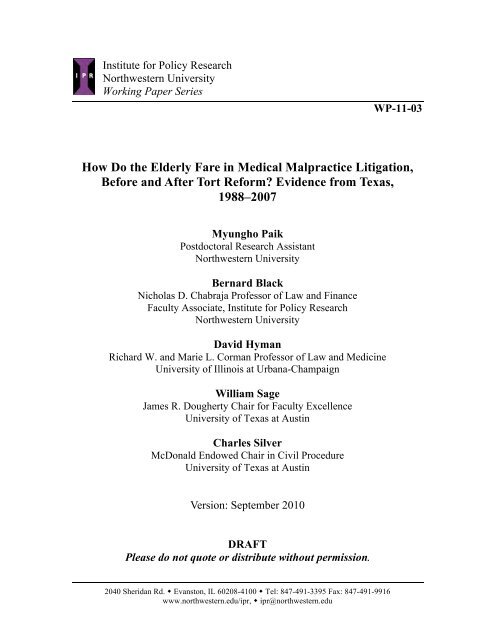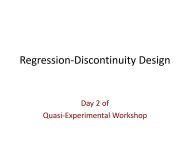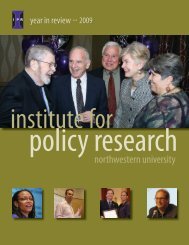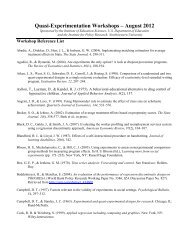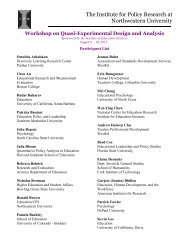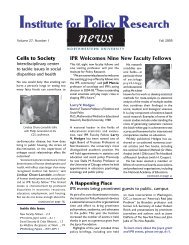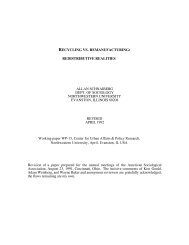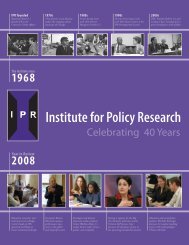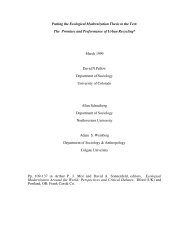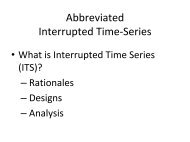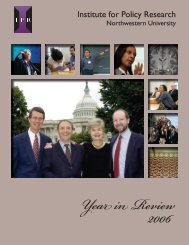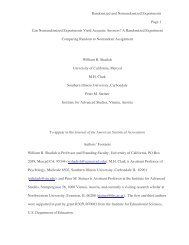Download working paper PDF - Institute for Policy Research ...
Download working paper PDF - Institute for Policy Research ...
Download working paper PDF - Institute for Policy Research ...
You also want an ePaper? Increase the reach of your titles
YUMPU automatically turns print PDFs into web optimized ePapers that Google loves.
<strong>Institute</strong> <strong>for</strong> <strong>Policy</strong> <strong>Research</strong><br />
Northwestern University<br />
Working Paper Series<br />
WP-11-03<br />
How Do the Elderly Fare in Medical Malpractice Litigation,<br />
Be<strong>for</strong>e and After Tort Re<strong>for</strong>m? Evidence from Texas,<br />
1988–2007<br />
Myungho Paik<br />
Postdoctoral <strong>Research</strong> Assistant<br />
Northwestern University<br />
Bernard Black<br />
Nicholas D. Chabraja Professor of Law and Finance<br />
Faculty Associate, <strong>Institute</strong> <strong>for</strong> <strong>Policy</strong> <strong>Research</strong><br />
Northwestern University<br />
David Hyman<br />
Richard W. and Marie L. Corman Professor of Law and Medicine<br />
University of Illinois at Urbana-Champaign<br />
William Sage<br />
James R. Dougherty Chair <strong>for</strong> Faculty Excellence<br />
University of Texas at Austin<br />
Charles Silver<br />
McDonald Endowed Chair in Civil Procedure<br />
University of Texas at Austin<br />
Version: September 2010<br />
DRAFT<br />
Please do not quote or distribute without permission.<br />
2040 Sheridan Rd. w Evanston, IL 60208-4100 w Tel: 847-491-3395 Fax: 847-491-9916<br />
www.northwestern.edu/ipr, w ipr@northwestern.edu
Abstract<br />
The elderly account <strong>for</strong> a disproportionate share of medical spending, but little attention<br />
has been paid to how they are treated by the medical malpractice system and to how that<br />
treatment is affected by tort re<strong>for</strong>m. The researchers compare paid medical malpractice<br />
claims (other than nursing home claims) brought by elderly and nonelderly plaintiffs<br />
from 1988 to 2007. Texas adopted a strict cap on noneconomic damages and other tort<br />
re<strong>for</strong>ms in 2003. During the pre-re<strong>for</strong>m period, elderly paid claims per inpatient day rose<br />
from roughly 20 percent to 50 percent of the adult nonelderly rate. The elderly received<br />
less per paid claim than the adult nonelderly and were far less likely to receive large<br />
awards, but mean and median awards converged. Post-re<strong>for</strong>m, there was a sharp drop in<br />
claims and payouts per claim <strong>for</strong> all ages, no evidence of further convergence, and mild<br />
evidence of post-re<strong>for</strong>m divergence in claiming by the very elderly. Thus, although tort<br />
re<strong>for</strong>m had a substantial effect, the authors find little evidence of a disparate impact on<br />
the elderly.<br />
This <strong>paper</strong> can be downloaded without charge from<br />
the Social Science <strong>Research</strong> Network electronic library at:<br />
http://ssrn.com/abstract=1605331<br />
The authors thank Eric Helland and participants in workshops at 2010 American Law<br />
and Economics Association Annual Meeting, Michigan Law School, and Northwestern<br />
University School of Law <strong>for</strong> comments.
I. INTRODUCTION<br />
The elderly account <strong>for</strong> a disproportionate share of medical spending. They are<br />
more prone than the non-elderly to be harmed by medical error, because they encounter the<br />
health care system more often, tend to have multiple medical conditions and medications,<br />
and are more fragile. Yet little attention has been paid to how the elderly are treated by the<br />
medical malpractice (“med mal”) system, or how they are affected by tort re<strong>for</strong>m. Past<br />
med mal studies have focused on overall system costs or on particular physician specialties<br />
or procedures, not on particular plaintiff groups.<br />
We begin here to rectify that gap. We study med mal claims by the elderly,<br />
excluding nursing home claims, using a unique closed claims database maintained by the<br />
Texas Department of Insurance covering 1988-2007. Texas enacted a strict cap on noneconomic<br />
damages (“non-econ cap”) and other tort re<strong>for</strong>ms <strong>for</strong> suits filed after Sept. 1,<br />
2003, so we can also assess how tort re<strong>for</strong>m affected elderly med mal claimants.<br />
During the pre-re<strong>for</strong>m period, controlling <strong>for</strong> health care utilization, the rate of paid<br />
med mal claims rose sharply <strong>for</strong> elderly claimants; in contrast, claim rates were roughly<br />
constant <strong>for</strong> the adult non-elderly; and fell <strong>for</strong> babies and children. By 2004 – roughly the<br />
end of the pre-re<strong>for</strong>m period, taking into account the delay between filing and claim<br />
closing -- elderly paid claims per inpatient day were roughly 50% of the adult non-elderly<br />
rate, or about 2.5 times higher than in 1988. During the pre-re<strong>for</strong>m period, the elderly<br />
received less per claim than the adult non-elderly, and were far less likely to receive<br />
“blockbuster” payouts, but mean and median payouts per claim had largely converged by<br />
2004. By 2004, payouts to elderly plaintiffs were close to 15% of all malpractice payouts<br />
– more than triple the 1988 level but still well below the elderly’s 35% share of medical<br />
spending. The elderly also settled their claims faster, and were less likely to take cases to<br />
trial.<br />
Post-re<strong>for</strong>m, the number of claims and mean payouts per claim dropped<br />
dramatically <strong>for</strong> all claimants, with no further convergence or divergence. This finding<br />
could reflect the combined effect of a long-term trend toward convergence, coupled with<br />
post-re<strong>for</strong>m divergence due to the greater impact of the non-econ cap on the elderly.<br />
However, the effects of the 2003 re<strong>for</strong>ms are not yet fully reflected in our data, so our<br />
conclusions are necessarily tentative. We expect to conduct a fuller analysis of the effects<br />
of Texas’ 2003 tort re<strong>for</strong>ms when more years of post-re<strong>for</strong>m data become available.<br />
Part II reviews the limited literature on malpractice claiming by the elderly and<br />
describes our dataset. Part III assesses med mal claims by elderly and non-elderly<br />
claimants and the impact of Texas’ 2003 re<strong>for</strong>ms. Part IV discusses our findings. Part V<br />
concludes.<br />
1<br />
Electronic copy available at: http://ssrn.com/abstract=1605331
II. LITERATURE REVIEW, DATA SOURCES & TORT REFORM<br />
A. Literature Review<br />
The empirical literature on med mal claiming by the elderly is modest and dated. 4<br />
Only one academic <strong>paper</strong> and one government report specifically study this topic. Sager et<br />
al analyzed Wisconsin malpractice claims from 1983-1984, and found that the elderly were<br />
significantly less likely to initiate malpractice suits. 5 A GAO report on malpractice claims<br />
against hospitals over 1986-1990 found that Medicare patients accounted <strong>for</strong> about 32% of<br />
hospital discharges and 44% of inpatient days but made only about 10% of claims and<br />
received about 10% of dollar payouts. 6 In addition, Studdert et al. examine factors that<br />
predict whether victims of medical negligence are likely to sue. They find that victims<br />
over age 75 were especially unlikely to file claims. 7<br />
A similarly small body of work examines how tort re<strong>for</strong>m affects elderly claimants.<br />
Using tried cases drawn from jury verdict reporters in three states, Finley concluded that<br />
non-econ caps hit the elderly harder than the non-elderly. 8 Conversely, Studdert et al.<br />
analyzed Cali<strong>for</strong>nia jury verdicts and found that elderly and non-elderly plaintiffs were<br />
affected similarly by the Cali<strong>for</strong>nia non-econ cap. 9<br />
This study is the first to present longitudinal evidence on med mal claiming by the<br />
elderly. We examine claim frequency, payout, and duration, both be<strong>for</strong>e and after tort<br />
re<strong>for</strong>m.<br />
In prior work, holding claiming rates constant, we estimated that the 2003 Texas<br />
non-econ cap would reduce aggregate payouts to elderly claimants in settled cases by 31%,<br />
compared to 16% <strong>for</strong> adult-non-elderly plaintiffs. 10 However, the mean of the per-case<br />
percentage reductions in payout was far smaller: 8% <strong>for</strong> elderly claimants v. 5% <strong>for</strong> adultnon-elderly<br />
claimants, and the difference between these percentages was not statistically<br />
significant. 11 The simulation methodology we used assumes no change in case mix and<br />
did not let us estimate the cap’s effect on claim frequency. News stories and surveys<br />
indicate that the Texas med-mal re<strong>for</strong>ms greatly reduced claim frequency. 12 Both news<br />
4 There is a more extensive literature on the frequency of medical error among elderly patients. Because<br />
our data does not allow us to address this issue, we do not discuss it further.<br />
5 Sager et al (1990).<br />
6 General Accounting Office (1993).<br />
7 Studdert et al (2000).<br />
8 Finley (2004).<br />
9 Studdert, Yang & Mello (2004).<br />
10 Hyman, Black, Silver, and Sage, Damage Caps (2009).<br />
11 Hyman, Black, Silver and Sage (2009).<br />
12 Carter (2006); Daniels and Martin (2009).<br />
2
articles and legal scholars have suggested that a non-econ cap will have a disproportionate<br />
impact on claiming by the elderly. 13<br />
B. Data Sources<br />
We study med mal claims by elderly plaintiffs against physicians and hospitals.<br />
We do not study claims against nursing homes. 14 Our data comes from the Texas Closed<br />
Claims Database (TCCD), a publicly-accessible database maintained by the Texas<br />
Department of Insurance (TDI). This database contains individual reports of all personal<br />
injury claims closed from 1988 on, covered by give lines of commercial insurance --<br />
mono-line general liability, auto, multi-peril, medical professional liability, and other<br />
professional liability -- involving payouts by all defendants of more than $10,000 in<br />
nominal dollars. Data are currently available through 2007. TDI checks the reports <strong>for</strong><br />
internal consistency and reconciles them against aggregate annual reports filed by each<br />
insurer. 15 We use this overall database to construct a dataset of med mal claims that includes<br />
the following cases.<br />
• Payout by all defendants is at least $25,000 in 1988 dollars (roughly $45,000 in<br />
2008 dollars) (“large paid claims”). 16<br />
• The claim meets two of the following three criteria:<br />
o It was paid under medical professional liability insurance;<br />
o It was against a physician or hospital;<br />
o It involved injuries caused by "complications or misadventures of medical<br />
or surgical care." 17<br />
13 E.g., Washburn (2002); Finley (2004); Daniels and Martin (2009); Rubin and Shepherd (2008).<br />
14 We study claims by the elderly against nursing homes separately. Paik, Hyman, Black and Silver<br />
(2010).<br />
15 This <strong>paper</strong> is one of a series using the Texas closed claims database to explore different aspects of<br />
medical malpractice and personal injury litigation. For an overview, see Black, Hyman, Silver, Zeiler, and<br />
Sage (2010). For a fuller discussion of the TCCD, the med mal dataset, and dataset limitations, see Black,<br />
Hyman, Silver and Sage, Defense Costs (2008). The Texas Department of Insurance (TDI) Closed Claim<br />
Reporting Guide (2004) (containing reporting instructions), the long and short <strong>for</strong>ms, summary “Closed<br />
Claim Annual Reports”, and the data on which we rely are available at http://www.tdi.state.tx.us.<br />
16 Claims with payout of $10,000-$25,000 are reported on a “Short Form”; claims with payout of at<br />
least $25,000 are reported on a "Long Form." The Long Form contains the nature of the injury, which we<br />
require to classify a claim as involving medical malpractice, and plaintiff age, which we need to study claims<br />
by the elderly; the Short Form omits this in<strong>for</strong>mation. We there<strong>for</strong>e study only Long Form claims. The<br />
reporting thresholds are not inflation-adjusted. Thus, some claims that were reported on the Long Form in<br />
later years would have been reported in earlier years on the Short Form if the thresholds had been inflation<br />
adjusted. To address this “bracket creep,” we limit the sample to cases with payout of at least $25,000 in<br />
1988 dollars. The large paid claims we study account <strong>for</strong> 99% of total payout on all paid claims. We convert<br />
payouts to 1988 dollars using the Consumer Price Index <strong>for</strong> All Urban Consumers (CPI). Source:<br />
www.bls.gov/cpi/. In regressions we define year as (calendar year – first year used in the regression (either<br />
1988 or 1990, depending on the regression).<br />
3
A “claim” is an incident causing bodily injury that results in a policyholder request to an<br />
insurer <strong>for</strong> coverage. An insurer must file a report with TDI in the year a claim “closes” --<br />
when the insurer “has made all indemnity and expense payments on the claim.” 18<br />
Many med mal cases involve multiple defendants. We review all claim reports to<br />
identify duplicate reports. When duplicate reports exist, we generally treat the last-filed<br />
report as the primary report. This report should capture any prior payouts by parties that<br />
were not required to file closed claim reports, such as self-insured hospitals. Our sample<br />
includes 15,173 nonduplicate cases involving total payouts over 1988-2007 of $4.7<br />
billion. 19 Dataset Limitations. The TCCD includes only “insured” claims. Most physicians<br />
carry malpractice insurance, but we lack data on claims against physicians employed by<br />
the University of Texas hospital system, which is self-insured. We similarly lack data on<br />
self-insured hospitals. We have data on plaintiff age, employment status, and county of<br />
injury, but not injury severity, gender, or county of residence. We lack data on cases with<br />
zero or small payout. We have data on the final plaintiff demand, but not on any earlier<br />
demands.<br />
Other data sources: We obtain estimated Texas population by age and year from<br />
the U.S. Census Bureau. 20 We obtain data on hospital discharges and hospital inpatient<br />
days by patient age <strong>for</strong> the “South” U.S. census region (which includes Texas) from the<br />
National Hospital Discharge Survey (NHDS). To estimate Texas discharges by patient<br />
age, we adjust this data <strong>for</strong> differences between the Texas age composition and that <strong>for</strong> the<br />
remainder of the South region. 21 We obtain data on US health care spending <strong>for</strong> selected<br />
17 We exclude claims against nursing homes from our sample. Other types of health-care providers (<strong>for</strong><br />
example, nurses and free-standing medical clinics) are not separately listed in the Long Form. We also<br />
include cases that meet one of the three criteria and are likely to involve medical malpractice. For example,<br />
we include 60 cases against physicians or hospitals which were paid under "other professional liability"<br />
rather than medical professional liability insurance. We exclude cases that meet two of the criteria, but seem<br />
unlikely to involve medical malpractice. Thus, we exclude cases paid under automobile liability insurance<br />
even if they meet the other two criteria. Details on our inclusion rules are available from the authors on<br />
request.<br />
18 TDI, Closed Claim Reporting Guide (2006), at 18.<br />
19 In 35 cases, the broader med mal dataset from which we draw our sample includes duplicate reports<br />
where one involves a nursing home but the other(s) involve a physician or hospital as defendant. We include<br />
the claim against the physician or hospital in our dataset. In identifying duplicate reports, we sometimes<br />
exercised judgment when claim reports were similar but not identical. Insurers also make some reporting<br />
errors that TDI does not catch. In a few cases when both the error and the correction were apparent, we<br />
corrected the underlying data. Details on the procedure we used to identify duplicates and the data<br />
adjustments we made are available from the authors on request. Claim reports may not capture all payouts<br />
by non-reporting defendants, either because the insurer which filed the last report was unaware of these<br />
payments or because the non-reporting defendant had not yet paid when the last report was filed.<br />
20<br />
The annual population estimates are available at www.census.gov/popest/states/, click on State<br />
Estimates by Demographic Characteristics, then download data file under State Single Year of Age and Sex<br />
Population Estimates.<br />
21<br />
The NHDS discharge data comes from the ICPSR website at<br />
http://www.icpsr.umich.edu/icpsrweb/ICPSR/series/43. The original source is National Hospital Discharge<br />
Survey, 1988-2007, National Center <strong>for</strong> Health Statistics (NCHS), at Centers <strong>for</strong> Disease Control. Our Texas<br />
4
years from the Centers <strong>for</strong> Medicare & Medicaid Services, and interpolate or extrapolate to<br />
estimate spending <strong>for</strong> other years. 22<br />
Age group categories. We generally focus on two broad age groups, adult nonelderly<br />
claimants (age 19-64) and elderly claimants (age 65 and over). For some analyses,<br />
we added baby/child (age 0-18), and separated elderly claimants into age brackets (ages<br />
65-74, 75-84, and 85 and over).<br />
C. 2003 Tort Re<strong>for</strong>m<br />
In 2003, Texas capped non-economic damages in med mal cases against physicians<br />
and other individual health care providers at $250,000 nominal ($161,000 in the 1988<br />
dollars we use in this article), with an additional $250,000 possible if a hospital or other<br />
health care institution is also liable, up to a maximum of two institutions, <strong>for</strong> a maximum<br />
overall cap of $750,000. The cap applies to suits filed after Sept. 1, 2003. This cap would<br />
be expected to reduce both claim frequency and payouts. Anecdotal evidence suggests a<br />
large impact on claim rates and payouts, as well as a decline of around 50% in med mal<br />
insurance premiums. 23 We do not study the effect of the cap on insurance premiums.<br />
Other components of the 2003 re<strong>for</strong>ms include making the death cap apply per<br />
claim, rather than per defendant, higher evidentiary standards <strong>for</strong> cases involving<br />
emergency room care, a requirement that plaintiffs file an expert report within 120 days of<br />
suit with regard to each defendant’s negligence (by a practicing physician, if the defendant<br />
is a physician), and a ten year statute of repose.<br />
There is one important complication in assessing the impact of the 2003 tort<br />
re<strong>for</strong>ms, which we return to below. For each closed claim with a lawsuit filed, we can<br />
determine whether the cap applies. But some claims close quickly, while others take<br />
longer – so the claims that are closed in any given post-re<strong>for</strong>m period are a mix of pre- and<br />
post-re<strong>for</strong>m claims. Claims that close in 2004 are almost entirely pre-re<strong>for</strong>m, while those<br />
that close in 2007 are mostly post-re<strong>for</strong>m. 24 Eventually, the “case-mix” will become 100%<br />
discharge estimates assume that Texas has the same ratio of discharges/population and patient<br />
days/population as the rest of the South region, both overall and <strong>for</strong> each age range; and similarly <strong>for</strong> our<br />
patient day estimates. As of January 2010, 2006 was the last year with NHDS data available; we<br />
extrapolated from 2006 to 2007. Because our data is from a closed claim database, we assign control<br />
variables – year, population, health care spending, and the like – based on the year in which a claim closes,<br />
rather than the year of injury or claim filing.<br />
22 Centers <strong>for</strong> Medicare & Medicaid Services, Office of the Actuary, National Health Statistics Group,<br />
National Health Expenditure Data by Age, at<br />
http://www.cms.hhs.gov/NationalHealthExpendData/04_NationalHealthAccountsAgePHC.asp#TopOfPage.<br />
Data is available <strong>for</strong> 1987, 1999, 1999, 2002, 2004, we interpolate <strong>for</strong> 1988-1995 using the 1987-1996 trend<br />
line, interpolate <strong>for</strong> 1997-2003 using surrounding years, and extrapolate to 2005-2007 using a linear trend<br />
based on 1996-2004 data.<br />
23 On claim frequency and payouts, see Carter (2006); Daniels and Martin (2009). On med mal premia,<br />
see Guardado (2009); Slavin (2010).<br />
24 Of the 14,106 suit-filed cases in our dataset, 846 were filed after Sept. 1, 2003. The re<strong>for</strong>ms affect<br />
0.3% of cases closed in 2003, 4.3% of cases closed in 2004, 17.6% of cases closed in 2005, 44.4% of claims<br />
closed in 2006, and 75.3% of claims closed in 2007. In an additional 206 claims closed from 2003-2007, the<br />
5
post-re<strong>for</strong>m. This complicates our regression analysis, since the results we observe in any<br />
given post-re<strong>for</strong>m year reflect a mix of pre- and post-re<strong>for</strong>m claims. Stated differently, the<br />
2003 re<strong>for</strong>ms either apply or don’t apply to any given claim, but the effects of tort re<strong>for</strong>m<br />
phase in over time when viewed across all closed claims.<br />
A. Overview<br />
III. Empirical Results<br />
We begin with an overview of the “bottom line” of total med mal payouts. Figure<br />
1 shows total payouts <strong>for</strong> elderly and non-elderly claimants, both pre- and post-re<strong>for</strong>m.<br />
The solid line shows total payouts to non-elderly plaintiffs; the dotted solid line shows<br />
total payouts to elderly plaintiffs (multiplied by four <strong>for</strong> visual presentation), and the rising<br />
dashed line shows the ratio of the two. As Figure 1 reflects, payouts to adult non-elderly<br />
claimants were roughly flat from 1990-2003, but crashed after tort re<strong>for</strong>m was enacted,<br />
from an average of about $160 million over 2001-2003 to only $48 million in 2007. 25<br />
Payouts to elderly claimants increased steadily from under $10 million during 1988-1990<br />
to around $40 million over 2001-2003, be<strong>for</strong>e dropping to $14 million in 2007. The share<br />
of total payouts received by elderly claimants increased from an average of less than 5%<br />
over 1988-1990 to around 15% over 2000-2003, with no clear post-re<strong>for</strong>m time trend. As<br />
Figure 1 shows, tort re<strong>for</strong>m has thus far had a similar impact on elderly and non-elderly<br />
claimants, despite suggestions of a greater effect on the elderly in the popular and<br />
academic literature (including our own simulation study). We explore below the extent to<br />
which the post-re<strong>for</strong>m trends we observe are attributable to changes in claim frequency,<br />
payouts per claim, or both.<br />
injury was prior to the effective date of the re<strong>for</strong>ms, but no lawsuit was filed, so we cannot conclusively<br />
determine whether the 2003 tort re<strong>for</strong>ms apply.<br />
25 Figure 1 includes 1988-1989. Under-reporting of claims during those years means that total payouts<br />
(the top two lines in the figure) will be low. We include these years in the figure because we have no reason<br />
<strong>for</strong> thinking that the under-reporting affects the ratio of payouts to elderly v. non-elderly claimants (the<br />
bottom line in the figure).<br />
6
Figure 1. Total Annual Payouts to Adult Non-Elderly and Elderly Claimants<br />
Total payout by year <strong>for</strong> elderly and adult non-elderly claimants (left scale), and ratio of elderly/total payout<br />
(right scale), <strong>for</strong> 12,108 nonduplicate, non-nursing-home, med mal cases closed from 1988-2007 with payout<br />
> $25,000 in 1988 dollars. Elderly payout is multiplied by 4 <strong>for</strong> better visual presentation. Amounts in 1988<br />
dollars.<br />
In Table 1, we turn from time trends to averages across all years in the dataset.<br />
Panel A presents summary statistics on claim frequency and payout, by type of paying<br />
defendant(s), and the fraction of claims and payouts attributable to elderly plaintiffs. Panel<br />
B presents summary in<strong>for</strong>mation on population, hospital discharges, inpatient days, and<br />
medical spending <strong>for</strong> different age groups. To assess the elderly’s use of the malpractice<br />
system, we need to adjust <strong>for</strong> their disproportionate use of medical care. Hospital<br />
discharges, inpatient days, and medical spending provide different measures of treatment<br />
intensity, which we use to control <strong>for</strong> exposure to malpractice risk. Below, we rely<br />
principally on inpatient days as an intensity measure, but verify robustness with the other<br />
measures. Inpatient days is our preferred measure because it is likely to best reflect the<br />
risk of medical error associated with health care. The elderly account <strong>for</strong> 10% of<br />
population, 27% of hospital discharges, 35% of medical spending, and 36% of inpatient<br />
days, but represent only 16% of large paid claims and 10% of payouts. 26<br />
Claims by the elderly, when made, are disproportionately likely to be against<br />
hospitals, rather than physicians. This could reflect the conventional wisdom that the<br />
elderly don’t often sue their doctors, the location and intensity of their medical care, or a<br />
combination of these factors.<br />
26 Each of the intensity measures has a time trend, even though the elderly share of total population is<br />
nearly constant at 10%. All three measures rise <strong>for</strong> the first half of our sample period, and fall in the second<br />
half; the decline is steepest <strong>for</strong> inpatient days.<br />
7
Table 1. Summary Statistics on Large Paid Claims, 1988-2007<br />
Panel A. Med Mal Claims<br />
Paying Defendant<br />
No. of<br />
Claims<br />
% Elderly<br />
Claimants<br />
Total Payout<br />
($M)<br />
% Paid to<br />
Elderly<br />
Claimants<br />
Physician 7,526 14.4% 1,537 11.8%<br />
Hospital 1,294 34.0% 329 20.0%<br />
Physician + Hospital 5,950 14.1% 2,760 7.3%<br />
Other 403 23.1% 76 23.6%<br />
Total 15,173 16.2% 4,702 9.9%<br />
Panel B: Medical Care Use<br />
Age Group<br />
% of<br />
Population<br />
% of Hospital<br />
Discharges<br />
% of<br />
Inpatient<br />
Days<br />
% of Health<br />
Care<br />
Spending<br />
Babies ( $25,000 in 1988 dollars. Payouts in millions of 1988<br />
dollars. Panel B: % of population, hospital discharges, hospital inpatient days, and health care spending<br />
represented by indicated age groups. Percentages may not sum to 100.0% due to rounding.<br />
Table 2 divides the sample into finer age ranges, and provides additional detail on<br />
payout per claim. We define a “claiming propensity” measure as the ratio of (percent of<br />
large paid claims) to (percent of inpatient days). This ratio is 1 by definition <strong>for</strong> the whole<br />
population, but it is 1.36 <strong>for</strong> adult non-elderly versus only 0.45 <strong>for</strong> the elderly. Among the<br />
elderly, claiming propensity declines with age; it is 0.65 <strong>for</strong> the young elderly (age 65-74),<br />
0.37 <strong>for</strong> the moderate elderly (age 75-84), and 0.24 <strong>for</strong> those 85 and older. The last two<br />
columns in Table 2 show a similar but milder pattern <strong>for</strong> mean and median payouts: higher<br />
payouts <strong>for</strong> adult non-elderly than <strong>for</strong> elderly claimants; and declining payouts with age<br />
among the elderly.<br />
Table 2. Large Paid Claims and Claiming Propensity by Age Group, 1988-2007<br />
Age Group<br />
% of<br />
population<br />
% of<br />
inpatient<br />
days<br />
% of<br />
Claims<br />
Claiming<br />
Propensity<br />
% of Payout/claim<br />
Total<br />
Payout Mean Median<br />
Baby/Child (0-18) 29.9% 17.6% 20.2% 1.15 33.6% 516 178<br />
Adult Non-Elderly (19-64) 60.1% 46.7% 63.6% 1.36 56.5% 275 125<br />
All Elderly (65+) 10.0% 35.6% 16.2% 0.45 9.9% 190 109<br />
Young Elderly: 65~74 5.6% 14.4% 9.4% 0.65 5.9% 196 117<br />
Moderate Elderly: 75~84 3.3% 14.0% 5.1% 0.37 3.1% 187 97<br />
Very Elderly: 85+ 1.1% 7.2% 1.7% 0.24 0.9% 162 85<br />
Percentages of population, inpatient days, and claims, claiming propensity ((% of claims)/(% of inpatient<br />
days)), percentage of total payout, and mean and median payout per claim <strong>for</strong> plaintiffs in indicated age<br />
8
anges, <strong>for</strong> 15,173 nonduplicate, non-nursing-home, med mal cases closed from 1988-2007 with payout ><br />
$25,000 in 1988 dollars. Amounts in 1988 dollars; total payouts in $ millions; per-claim payouts in $<br />
thousands. Percentages may not sum to 100.0% due to rounding.<br />
B. Claim Frequency<br />
We turn next to an analysis of time trends in claim frequency. Figure 2 shows time<br />
trends in the number of large paid claims by elderly and adult non-elderly claimants per<br />
100,000 population from 1990-2007. We omit 1988-1989 because of underreporting in<br />
these years, which TDI addressed beginning in 1990. 27 Claims per 100,000 persons by the<br />
adult non-elderly were roughly flat through 2003, but then declined from 4.6 in 2003 to 2.5<br />
in 2007. In contrast elderly claims per 100,000 persons increased dramatically during the<br />
pre-re<strong>for</strong>m period, from 2.4 in 1990 to 9.2 in 2003, be<strong>for</strong>e falling to 4.7 in 2007. 28 We<br />
confirm the apparent structural break, coinciding with the Texas re<strong>for</strong>ms, in regression<br />
analyses below.<br />
Figure 2. Time Trends in Claiming by Age Group<br />
Large paid claims per 100,000 people <strong>for</strong> elderly and adult non-elderly plaintiffs <strong>for</strong> 11,326 nonduplicate,<br />
non-nursing-home, med mal cases closed from 1990-2007 with payout > $25,000 in 1988 dollars. 1988 and<br />
1989 are omitted due to underreporting in these years.<br />
Rates per unit population do not take into account the elderly’s more intense use of<br />
medical care. In Figure 3, we show the ratio of the elderly to adult non-elderly claim rate,<br />
controlling separately <strong>for</strong> hospital discharges, inpatient days, and share of health care<br />
27 We have no reason to expect bias in which claims went unreported, so we include 1988-1989 in all<br />
analyses except those which involve claim rates, either absolute or relative to an absolute denominator such<br />
as population.<br />
28 We lack data on unpaid claims and small paid claims, but have no reason to think there were large<br />
time trends in the fraction of claims that result in a payout large enough to be included in our dataset. Thus,<br />
the trends in large paid claims likely reflect similar trends in total paid claims.<br />
9
spending. Figure 3 begins in 1988, because we have no reason to believe that<br />
underreporting in 1988-1989 affected these ratios.<br />
Figure 3. Time Trends in Claiming by Age Group<br />
Ratio of elderly to adult non-elderly claim rates, adjusted <strong>for</strong> number of hospital discharges and inpatient<br />
days and share of US healthcare spending, <strong>for</strong> 12,108 nonduplicate, non-nursing-home, med mal cases closed<br />
from 1988-2007 with payout > $25,000 in 1988 dollars.<br />
The trends are qualitatively similar <strong>for</strong> all three intensity measures. The relative<br />
frequency of claims by the elderly rises strongly through the early 2000s, but then levels<br />
off well below the adult non-elderly level. Controlling <strong>for</strong> inpatient days – our preferred<br />
intensity measure – the elderly/adult non-elderly ratio rises from 20% at the end of the<br />
1980s to about 50% in the early 2000s.<br />
We turn next to regression analysis of time trends in the frequency of large paid<br />
claims per 100,000 inpatient days, using year, a constant term, and a structural break<br />
variable, which we call “post-re<strong>for</strong>m period,” to reflect the extent to which the 2003<br />
re<strong>for</strong>ms influence claim rates in each post-re<strong>for</strong>m year. 29 This variable, which is zero <strong>for</strong><br />
years be<strong>for</strong>e 2003, nearly zero <strong>for</strong> 2003, and rises toward 1 thereafter, must be constructed<br />
with care. The observed ratio of post-re<strong>for</strong>m claims to total claims in a given year is<br />
biased downward by the re<strong>for</strong>ms, which suppress post-re<strong>for</strong>m claims. 30 As detailed in the<br />
Appendix, we there<strong>for</strong>e use pre-re<strong>for</strong>m data on claim survival times to estimate the<br />
29 In this and all other regressions, year is coded as year – first year in sample. Thus, in Table 3, year is<br />
coded as year – 1990. In a regression with year and constant term as the only independent variables, the<br />
coefficient on the constant term is the estimated value of the dependent variable in the first year in the<br />
sample.<br />
30 For example, suppose that in a given period, we would expect: (i) without the effect of the re<strong>for</strong>ms on<br />
claim rate, to see 20 large paid claims; (ii) half of these hypothetical claims would be pre-re<strong>for</strong>m; and (iii)<br />
re<strong>for</strong>m reduces claim rates by 50%. We would then observe 10 pre-re<strong>for</strong>m and 5 post-re<strong>for</strong>m claims. Twothirds<br />
of observed claims (10/15) will be pre-re<strong>for</strong>m. We would wrongly infer that we are only 1/3 of the<br />
way into the post-re<strong>for</strong>m period, instead of half-way.<br />
10
structural break variable. We estimate this variable separately <strong>for</strong> adult non-elderly,<br />
elderly, all non-elderly, or all claims, as appropriate <strong>for</strong> a particular regression. The postre<strong>for</strong>m<br />
period variable reaches 0.83 <strong>for</strong> all claims (0.90 <strong>for</strong> elderly claims) in 2007, the last<br />
year <strong>for</strong> which we have data.<br />
Table 3. Claims per 100,000 Inpatient Days<br />
Regression (1) (2) (3) (4) (5) (6) (7)<br />
Age 0-18 19-64 65+ 65-74 75-84 85+ all ages<br />
Year<br />
-0.153 0.201 0.263 0.325 0.247 0.204 0.173<br />
[2.55]** [2.84]** [19.03]*** [11.46]*** [10.86]*** [6.09]*** [4.51]***<br />
Post-re<strong>for</strong>m -2.58 -6.34 -2.81 -3.84 -2.24 -2.20 -4.32<br />
period [2.21]** [5.15]*** [9.30]*** [6.29]*** [5.59]*** [4.03]*** [6.58]***<br />
Constant<br />
8.42 7.33 1.01 1.89 0.53 0.06 5.09<br />
[17.14] [14.73] [7.59] [6.83] [3.61] [0.22] [17.78]<br />
Observations 18 18 18 18 18 18 18<br />
Adjusted R 2 0.690 0.543 0.907 0.783 0.890 0.709 0.670<br />
% drop postre<strong>for</strong>m<br />
-40.1% -63.8% -63.4% -62.8% -59.9% -81.1% -58.9%<br />
Ordinary least squares regressions <strong>for</strong> indicated age groups, of claims per 100,000 inpatient days, included in<br />
dataset of 14,135 nonduplicate, non-nursing-home, med mal cases closed from 1990-2007 with payout ><br />
$25,000 in 1988 dollars. Post-re<strong>for</strong>m period is estimated probability that claim closed in each year was filed<br />
pre-re<strong>for</strong>m, computed separately <strong>for</strong> elderly and non-elderly plaintiffs. 1988 and 1989 are omitted due to<br />
underreporting in these years. Last row shows ratio of (post-re<strong>for</strong>m period claim rate)/(predicted 2003 claim<br />
rate). t statistics, based on robust standard errors, are in parentheses. *, **, *** indicate significance at the<br />
10%, 5%, and 1% levels (omitted <strong>for</strong> constant term). Significant results (at 5 percent or better) are in<br />
boldface.<br />
Table 3 presents our results on claim rates. As regressions (1) and (2) indicate,<br />
there is a modest upward trend in adult non-elderly claims, but a decline in claims<br />
involving babies and children (ages 0-18). 31 Regression (3) shows the strong rise in prere<strong>for</strong>m<br />
claim frequency <strong>for</strong> elderly plaintiffs. (The much smaller constant term in<br />
regression (3) indicates that the elderly start from a much lower initial claim rate). As<br />
regressions (4)-(6) show, the claim rate rose <strong>for</strong> all three elderly sub-groups. In Chow tests<br />
<strong>for</strong> differences in coefficients between elderly subgroups, the differences are statistically<br />
significant (p < .01). Thus, the rate of increase in claim rates was larger <strong>for</strong> the young<br />
elderly, and smaller <strong>for</strong> the very elderly. However, the very elderly began from a lower<br />
base (shown by the constant term in the regression). The percentage increase in claiming<br />
rate (not reported) is highest <strong>for</strong> the very elderly.<br />
Post-re<strong>for</strong>m, there is a sharp drop in claiming by all groups. We can estimate the<br />
effect of tort re<strong>for</strong>m on claim rates by using the regressions in Table 3 to predict claim<br />
31 The difference between the positive coefficient <strong>for</strong> adult non-elderly claims in Table 3, and the<br />
roughly flat line in Figure 2 reflects the difference between the denominators – 100,000 inpatient days in<br />
Table 3 v. 100,000 population in Figure 2. In unreported regressions, we find that baby claims (age 0-1)<br />
decreased by 0.18 claims per 100,000 hospital days per year during the period, and claims by children (age 1-<br />
18) dropped by 0.12 claims per 100,000 hospital days per year. The trend <strong>for</strong> baby claims is statistically<br />
significant, while that <strong>for</strong> child claims is not significant.<br />
11
ates in 2003, and then use the coefficient on post-re<strong>for</strong>m period to predict the percentage<br />
drop if the re<strong>for</strong>m had applied immediately to all claims. 32 These percentages are shown in<br />
the last row of Table 3. The decline is 40% <strong>for</strong> babies and children, 64% <strong>for</strong> adult nonelderly,<br />
and 63% <strong>for</strong> elderly plaintiffs. Within the elderly, the percentage decline is similar<br />
<strong>for</strong> ages 65-74 (63%) and 75-84 (60%), but rises to 81% <strong>for</strong> the very elderly (85+). Thus,<br />
claim rates drop by similar percentages <strong>for</strong> the elderly and the adult-non-elderly, with some<br />
evidence of a larger impact on the very elderly. Tort re<strong>for</strong>m had a less extreme, but still<br />
strong impact on babies and children.<br />
C. Payout per Claim<br />
Panel A of Figure 4 shows time trends in mean payout per claim <strong>for</strong> elderly and<br />
adult non-elderly claimants; Panel B shows time trends in median payouts. Over 1988-<br />
2003, mean payout to the adult non-elderly was flat to gently declining, with substantial<br />
year-to-year variation. In contrast, mean payout to the elderly was rising, but remained<br />
well below the adult non-elderly level. After 2003, payout per claim drops <strong>for</strong> both<br />
groups. The gap between the two groups continues to shrink, and is essentially gone in<br />
2006-2007.<br />
As Panel B reflects, median payouts present a similar picture. Median payout to<br />
adult non-elderly claimants decreased steadily over our sample period, even prior to tort<br />
re<strong>for</strong>m. Median payout to the elderly increased prior to tort re<strong>for</strong>m, but fell after re<strong>for</strong>m.<br />
By 2006, the gap between the two groups had closed.<br />
32 The predicted 2003 claim rate is given by (coefficient on constant term) + (2003-1990) * (coefficient<br />
on year term). The fractional decline due to re<strong>for</strong>m is (coefficient on post-re<strong>for</strong>m period)/(predicted 2003<br />
claim rate).<br />
12
Figure 4. Payout per Claim: Elderly vs. Adult Non-Elderly<br />
Mean and median payout per claim by year <strong>for</strong> elderly and adult non-elderly claimants, <strong>for</strong> 12,108<br />
nonduplicate, non-nursing home, med mal cases closed from 1988-2007 with payout > $25,000 in 1988<br />
dollars. Amounts in 1988 dollars.<br />
We also used regression analysis to examine how the 2003 re<strong>for</strong>ms affected<br />
payouts. Table 4, regressions (1) and (2) are simple regressions <strong>for</strong> adult non-elderly and<br />
elderly claimants, with ln(payout) as dependent variable, and year, a post-re<strong>for</strong>m dummy<br />
(=1 if the claim was subject to the non-econ cap, 0 otherwise) and a constant term as<br />
independent variables. The coefficient on year is positive <strong>for</strong> elderly claimants (1.0% per<br />
year) but insignificant <strong>for</strong> the adult non-elderly. Post re<strong>for</strong>m, payout per claim drops<br />
sharply, by 29% <strong>for</strong> adult non-elderly claimants and 33% <strong>for</strong> elderly claimants. 33<br />
In regressions (3)-(6), we switch to a pooled sample of adult claimants, and add<br />
various control variables. In regression (3), we use ln(age +1) and employment status as<br />
controls. The overall time trend is insignificant. As expected, ln(age+1) takes a negative<br />
coefficient, indicating that older plaintiffs receive smaller payouts. In regressions (4)–(6)<br />
we use a dummy <strong>for</strong> elderly claimants, instead of a continuous age variable, with adultnon-elderly<br />
as the omitted group. The elderly are paid about 13% less than the adult nonelderly,<br />
on average.<br />
33 Here and in other regressions with ln(payout) as the dependent variable, we obtain percentage change<br />
estimates by taking the exponent of the coefficient. For example, in regression (1), e -0.346 = 0.71, which<br />
implies a 29% predicted drop in per claim payouts.<br />
13
Table 4. Regressions: Payout per Claim and Claimant Age<br />
Dep. variable<br />
Ln(payout)<br />
Regression (1) (2) (3) (4) (5) (6)<br />
Age 19-64 65+ All adults (19+)<br />
Year<br />
-0.0027 0.0098 -0.0005 -0.0004 -0.0026 -0.0015<br />
[1.22] [2.48]** [0.28] [0.20] [1.20] [0.64]<br />
Year * Elderly<br />
0.0125 0.013<br />
[2.77]*** [2.87]***<br />
Post-re<strong>for</strong>m dummy<br />
-0.3455 -0.4062 -0.3558 -0.3583 -0.3462 -0.3604<br />
[8.99]*** [6.22]*** [10.70]*** [10.78]*** [9.01]*** [9.14]***<br />
Post-re<strong>for</strong>m dummy *<br />
-0.0607 -0.0639<br />
Elderly [0.80] [0.84]<br />
Immediate pre-re<strong>for</strong>m<br />
-0.0905<br />
suit dummy [2.20]**<br />
Employed<br />
0.0649 0.0345 0.0348 0.0351<br />
[3.20]*** [1.64] [1.65]* [1.67]*<br />
ln (age + 1)<br />
-0.0773<br />
[2.66]***<br />
Elderly dummy (65+)<br />
-0.1362 -0.2690 -0.2734<br />
[5.63]*** [5.02]*** [5.10]***<br />
Constant<br />
11.87 11.59 12.09 11.83 11.85 11.84<br />
[498.99] [247.44] [103.29] [466.13] [435.99] [429.58]<br />
Observations 9,650 2,458 12,108 12,108 12,108 12,108<br />
Adjusted R 2 0.0076 0.0113 0.0101 0.0117 0.0121 0.0123<br />
Ordinary least squares regressions of payout/claim <strong>for</strong> 12,108 nonduplicate, non-nursing-home med mal<br />
cases closed from 1988-2007 with payout > $25,000 in 1988 dollars. Adult non-elderly (age 19-64) is the<br />
omitted category in regressions (4)-(6). Amounts in 1988 dollars. t-statistics, based on robust standard<br />
errors, are in parentheses. *, **, *** indicate significance at the 10%, 5%, and 1% levels respectively<br />
(omitted <strong>for</strong> constant term). Significant results (at 5% level) are in boldface.<br />
In Regression (5) we add interaction terms (year * elderly) and (post re<strong>for</strong>m<br />
dummy * elderly). The (year * elderly) interaction term takes a positive and significant<br />
coefficient, consistent with elderly payouts rising relative to other claimants. The (post<br />
re<strong>for</strong>m dummy * elderly) term is negative but insignificant. Although insignificant, the<br />
negative coefficient is consistent with our prediction in separate work that the elderly<br />
would suffer a larger payout decline due to the non-econ cap. 34<br />
Finally, in regression (6) we add an “immediate pre-re<strong>for</strong>m suit” dummy (=1 if suit<br />
filed during Jun-August, 2003). This dummy capture the spike in filings just prior to the<br />
effective date <strong>for</strong> the 2003 re<strong>for</strong>ms, to address the possibility that these cases differ from<br />
other pre-re<strong>for</strong>m cases. 35 The immediate pre-re<strong>for</strong>m cases are indeed different: they<br />
produce lower payouts on average, as indicated by the negative coefficient.<br />
D. The elements of damages<br />
34 Hyman, Black, Silver, and Sage, Damage Caps (2009).<br />
35 One reason to expect a difference: Some of these filings were rushed to meet the deadline, hence the<br />
underlying claims might be weaker on average. A second reason, which we discuss further below: These<br />
claims were closed after the re<strong>for</strong>ms were adopted; publicity associated with the political push <strong>for</strong> re<strong>for</strong>m<br />
about runaway juries and excessive awards could have influenced expected awards, even if the pre-re<strong>for</strong>m<br />
rules still applied.<br />
14
Compensatory damages can be either economic or non-economic, and the 2003 tort<br />
re<strong>for</strong>ms capped only the latter. Thus, it is worth assessing how the breakdown of damages<br />
differs between elderly and adult non-elderly plaintiffs. We focus on tried cases, where<br />
the award at trial provides this breakdown <strong>for</strong> awarded damages. 36 We estimate paid<br />
damages of each type, assuming that payouts are allocated first to economic damages,<br />
second to non-econ damages, and third to punitive damages. 37<br />
Table 5, Panel A, reports mean and median “per case” ratios and the aggregate ratio<br />
of paid economic damages to total damages <strong>for</strong> adult non-elderly and elderly plaintiffs.<br />
However measured, elderly plaintiffs receive a lower proportion of paid economic<br />
damages. The difference is greatest <strong>for</strong> the aggregate ratio, where only 36% of elderly<br />
payouts are attributable to economic damages, compared to 71% <strong>for</strong> the adult non-elderly.<br />
Table 5. Paid Damages by Plaintiff Age and Type of Damages<br />
Panel A. Paid Economic Damages: Percentages in Tried Cases<br />
Age group<br />
No. of<br />
cases<br />
Paid economic damages/total payout<br />
Mean percase<br />
ratio<br />
Median percase<br />
ratio<br />
Aggregate<br />
ratio<br />
Adult Non-elderly (19-64) 251 49.7% 40.7% 71.0%<br />
Elderly (65+) 43 37.7% 24.5% 35.5%<br />
Elderly/Adult Non-elderly 76% 60% 50%<br />
Mean per case, median per case, and aggregate ratio of paid economic damages/total payout, <strong>for</strong> 294<br />
nonduplicate, non-nursing home, med mal cases involving adult plaintiffs with plaintiff verdicts, closed from<br />
1988-2007 with payout > $25,000 in 1988 dollars. Amounts in 1988 dollars.<br />
Panel B reports mean and median paid economic and (non-economic + punitive)<br />
damages <strong>for</strong> adult non-elderly and elderly plaintiffs. As Panel B reflects, mean paid<br />
economic damages <strong>for</strong> adult non-elderly plaintiffs are $245,000 versus only $70,000 <strong>for</strong><br />
elderly plaintiffs. The pattern reverses <strong>for</strong> paid (non-econ + punitive) damages; the mean<br />
36 For settled cases we do not have a reliable breakdown between economic and non-economic damages.<br />
The claim reporting <strong>for</strong>m asks insurers to first assess whether the settlement “was influenced by a demand <strong>for</strong><br />
or possible award of non-economic exemplary damages or pre-judgment interest.” If yes, insurers are asked<br />
to provide a breakdown. Insurers provide this breakdown in only 35% of all settled cases. It seems likely<br />
that in many of these cases, the insurer judged that the settlement amount was less than economic damages –<br />
which is not the same thing as there being zero expected non-econ damages if the plaintiff were to win at<br />
trial. According to these insurer allocations, non-economic damages accounted <strong>for</strong> 29% of payouts to elderly<br />
claimants in settled cases v. 25% of payouts to adult non-elderly claimants. We discuss insurer allocations in<br />
Black, Hyman & Silver (2010).<br />
37 See Black, Hyman and Silver (2009) <strong>for</strong> details on our procedure <strong>for</strong> estimating damages. In brief,<br />
we first determine the allowed damages of each type, after all damage caps, including pre- and post-judgment<br />
interest on each type of damage. We then allocate the payout to allowed damages as follows: (i) To allowed<br />
economic damages until payout is exhausted or these damages are fully paid ("paid economic damages"); (ii)<br />
to allowed non-econ damages until payout is exhausted or these damages are fully paid ("paid non-econ<br />
damages"); (iii) to allowed punitive damages until payout is exhausted or these damages are fully paid ("paid<br />
punitive damages"). In 30 of the 361 trials in our dataset, defendants pay more than the allowed verdict, with<br />
a mean (median) of $271,000 (69,000). We exclude this “payout bonus” from our analysis.<br />
15
<strong>for</strong> adult non-elderly plaintiffs is $100,000 v. $127,000 <strong>for</strong> elderly plaintiffs. 38<br />
awards show a similar pattern.<br />
Median<br />
Panel B. Paid Damage in Tried Cases: Amounts<br />
Damages type Economic damages Non-econ + punitive damages<br />
Age group Mean Median Mean Median<br />
Adult Non-elderly 245 50 100 63<br />
Elderly 70 36 127 119<br />
Elderly/Adult Non-Elderly 28.5% 72.9% 127% 188%<br />
Mean and median amounts of paid economic damages and paid (non-economic + punitive damages), <strong>for</strong> 294<br />
nonduplicate, non-nursing home, med mal cases involving adult plaintiffs with plaintiff verdicts, closed from<br />
1988-2007 with payout > $25,000 in 1988 dollars. Amounts in thousands of 1988 dollars.<br />
Thus, the lower mean payouts to elderly plaintiffs are partly explained by lower<br />
economic damages. To be sure, this is not the whole story. It is plausible, indeed likely,<br />
that attorneys will only accept cases with low economic damages if expected (noneconomic<br />
+ punitive damages) are relatively high. The evidence in Panel B is consistent<br />
with this selection effect.<br />
E. Blockbuster Payouts<br />
Med mal payouts have a strong positive skew – a limited number of large payouts<br />
account <strong>for</strong> a significant fraction of the total dollars paid by defendants and their insurers.<br />
We saw in Figure 4 that mean payouts are substantially lower <strong>for</strong> elderly than <strong>for</strong> nonelderly<br />
plaintiffs. In contrast the differences in median payouts to the two groups are<br />
smaller, although both differences largely disappear over our sample period. This pattern<br />
suggests that over the full sample period, the elderly are less likely to receive very large<br />
payouts. We confirm this by examining the largest (“blockbuster”) payouts in our dataset.<br />
As Figure 4 reflects, the top 100 (200) claims are only 0.7% (1.4%) of total claims, but<br />
account <strong>for</strong> 14.5% (21.7%) of total payouts. 39<br />
As Figure 4 shows, although the elderly account <strong>for</strong> 16% of all claims (see Table<br />
2), they account <strong>for</strong> only 1% of the largest 100 or 200 claims (one of the top 100; two of<br />
the top 200). Both of these payouts were in death cases, which likely had small economic<br />
damages (we cannot be sure because both cases settled be<strong>for</strong>e trial). Both preceded the<br />
2003 non-econ cap. If the non-econ cap had applied during our entire sample period, it is<br />
possible that none of the top 200 payouts would have gone to an elderly claimant.<br />
38 There are only 12 post-cap trials in our dataset, of which 2 involve elderly plaintiffs. This is too few<br />
<strong>for</strong> us to directly assess how the non-econ cap affects allowed awards and payouts in tried cases.<br />
39 The top 100 claims account <strong>for</strong> $637M in payouts, and the top 200 claims account <strong>for</strong> $954M.<br />
16
FIGURE 4. Distribution of Largest Payout Claims by Age Group<br />
Percent of all payouts, and top 100 (200) claims made to claimants in indicated age ranges, <strong>for</strong> 15,173<br />
nonduplicate cases included in med mal dataset of cases closed from 1988-2007 with payout > $25,000 in<br />
1988 dollars, excluding nursing home cases. Amounts in 1988 dollars.<br />
In blockbuster cases, the most common injury is brain damage/spinal cord injuries<br />
(70 of the top 100 cases, and 141 of the top 200), which often require costly long-term<br />
care. The second most common injury is death (8 of the top 100 cases, and 23 of the top<br />
200), even though Texas caps damages plus prejudgment interest in death cases at roughly<br />
$975,000 (prior to 2003, this cap was per defendant).<br />
E. Claim Duration<br />
Elderly claims settle faster than adult non-elderly claims. Table 6 provides<br />
summary statistics on claim duration. The mean duration (from injury to closing) <strong>for</strong><br />
elderly claimants is 3.47 years versus 3.98 years <strong>for</strong> adult non-elderly claimants – a<br />
difference of 0.5 years. The difference in median duration is 0.3 years. As Table 6<br />
reflects, claim duration is shorter <strong>for</strong> elderly claimants partly because they bring claims<br />
more quickly after they are injured, and partly because their claims close faster once they<br />
are brought. 40<br />
40 In robustness checks, we obtain similar results if we limit the sample to cases with suit filed.<br />
17
Table 6. Claim Duration<br />
Duration<br />
Injury to Close<br />
Claim Opening to Close<br />
Mean Median Mean Median<br />
Adult Non-elderly (19-64) 3.98 3.63 2.55 2.22<br />
Elderly (65+) 3.47 3.33 2.30 2.04<br />
Adult Non-elderly - Elderly 0.50 0.30 0.26 0.18<br />
t-stat <strong>for</strong> mean or χ 2 (p-value)<br />
61.81<br />
27.75<br />
11.37***<br />
7.54***<br />
<strong>for</strong> median<br />
(0.000)***<br />
(0.000)***<br />
Mean and median claim duration in years <strong>for</strong> 12,108 nonduplicate, non-nursing-home, med mal cases closed<br />
from 1988-2007 with payout > $25,000 in 1988 dollars. Last row reports t-statistics <strong>for</strong> difference in means,<br />
and χ 2 <strong>for</strong> difference in medians (p-value in parentheses) *, **, *** indicate significance at the 10%, 5%, and<br />
1% levels respectively. Significant results (at 5% level) are in boldface.<br />
We also analyzed non-parametric Kaplan-Meier survival curves <strong>for</strong> the period from<br />
injury to close, using cases that settled be<strong>for</strong>e trial completion. The elderly claim survival<br />
curve was consistently below the non-elderly curve. 41 For example, four years after injury,<br />
70% of claims by the elderly are settled, compared to 58% of claims by the non-elderly. In<br />
unreported regressions, we confirm that elderly claims close faster over the full sample<br />
period, but also find evidence of convergence: the duration of elderly claims increases by<br />
around 1.1% per year; there is no similar trend <strong>for</strong> non-elderly claims.<br />
In unreported regressions, we find that duration drops post-re<strong>for</strong>m by about 44%,<br />
<strong>for</strong> elderly plaintiffs and about 32% <strong>for</strong> adult non-elderly plaintiffs. This difference in<br />
re<strong>for</strong>m effects is also statistically significant. The reasons <strong>for</strong> this drop are not clear. One<br />
speculation: Post-re<strong>for</strong>m, plaintiffs’ lawyers are more likely to avoid complex cases, so<br />
the cases they bring close faster. Alternatively, if tort re<strong>for</strong>m encourages plaintiff’s<br />
lawyers to drop weaker cases (by making them less remunerative), the remaining “strong”<br />
cases may settle more quickly. We are unable to evaluate these explanations with our data.<br />
F. Stage of Resolution<br />
The elderly are more likely than the adult non-elderly to resolve a large paid claim<br />
without a lawsuit, and less likely to take a case to trial. Within the elderly, the likelihood<br />
of resolution without a lawsuit rises with age. Table 7 provides summary statistics.<br />
41 A log-rank test strongly rejects the null of equal survival functions (χ 2 = 291, p = 0.0000).<br />
18
Table 7. Stage at Which Claims are Resolved<br />
Age Group % No Suit Filed % Trial<br />
Adult non-elderly (19-64) 6.8% 3.1%<br />
Elderly (65+) 10.6% 2.3%<br />
Young Elderly (65-74) 9.2% 2.3%<br />
Moderate Elderly (75-84) 10.8% 2.6%<br />
Very Elderly (85+) 17.3% 1.4%<br />
Elderly - Adult non-elderly 3.9% -0.8%<br />
t-statistic (6.70)*** (2.09)**<br />
Very elderly (85+) – Other Elderly 7.5% -1.0%<br />
t-statistic (3.74)*** (0.95)<br />
Fraction of claims resolved without trial and after full trial <strong>for</strong> elderly and adult non-elderly plaintiffs, <strong>for</strong><br />
12,108 nonduplicate, non-nursing-home, med mal cases closed from 1988-2007 with payout > $25,000 in<br />
1988 dollars. Tried cases are reported as percent of cases with suit filed. Selected t-statistics <strong>for</strong> difference<br />
in means in parentheses. *, **, *** indicate significance at the 10%, 5%, and 1% levels respectively.<br />
Significant results (at 5% level) are in boldface.<br />
A. Convergence, Interrupted<br />
V. Discussion<br />
We document a pattern of convergence in claim frequency and payouts to elderly<br />
versus adult non-elderly claimants during 1988-2003. After Texas adopted med mal<br />
re<strong>for</strong>ms in 2003, including a relatively strict cap on non-econ damages, the convergence in<br />
claim rates apparently stalled. To be sure, any conclusions about the post-re<strong>for</strong>m period<br />
are tentative, because we have only 3 years with a significant number of post-re<strong>for</strong>m<br />
claims (2005-2007). Below, we address possible explanations <strong>for</strong> the rise and apparent<br />
post-re<strong>for</strong>m stall in convergence in claim rates, and the near-complete convergence in<br />
payouts per claim.<br />
B. Why Did Elderly Claims Rise Over 1988-2003?<br />
We find a 2.5-fold rise over 1988-2003 in the rate of large paid claims by elderly<br />
plaintiffs, relative to the adult nonelderly rate, controlling <strong>for</strong> health care intensity.<br />
Possible explanations include (i) greater physician willingness to per<strong>for</strong>m risky procedures<br />
on elderly patients, some of which lead to malpractice claims; (ii) a cultural shift toward<br />
greater willingness by the elderly to initiate a claim; and (iii) increased willingness of<br />
lawyers to take these claims. 42 We cannot differentiate among these explanations with our<br />
data, and they might well act synergistically.<br />
C. Why Are Elderly Claim Rates Lower than Non-Elderly Rates?<br />
42 Fragility (elderly more likely to be injured than non-elderly) should be captured by our control <strong>for</strong><br />
intensity, unless fragility is increasing.<br />
19
Although claims by the elderly increased substantially, the elderly still bring claims<br />
much less often than the adult non-elderly, adjusted <strong>for</strong> health care intensity. For example,<br />
in recent years, the inpatient-days-adjusted elderly claim rate has been about 50% of the<br />
adult non-elderly rate. Possible reasons include reluctance to bring suit, especially against<br />
physicians (see Table 1), lesser familiarity of med mal lawyers with elderly claims, and<br />
lower expected damages <strong>for</strong> many claims. All of these explanations seem plausible; we<br />
cannot distinguish between them with our data.<br />
D. Why Were Elderly Per-Claim Payouts Smaller – and Why Did They Converge?<br />
Mean and median payouts to the elderly and adult non-elderly effectively<br />
converged during the period we study. There remains, however, an almost total absence of<br />
very large payouts to the elderly. The small number of very large payouts could reflect<br />
lower economic damages among the elderly. The elderly are unlikely to have large lost<br />
earnings, and their medical expenses will often be more modest than those <strong>for</strong> the adult<br />
non-elderly because they have a shorter remaining life-span during which to incur these<br />
expenses.<br />
The relative increase in elderly payouts over 1988-2003 could be partly explained<br />
by the rising life expectancy of the elderly and their somewhat greater tendency to still be<br />
<strong>working</strong>. 43 It could also be related to the increase in claim rates, which might be<br />
accompanied by a different mix of elderly claims. As be<strong>for</strong>e, we cannot distinguish<br />
between these explanations with our data.<br />
E. Effects of Tort Re<strong>for</strong>m<br />
The 2003 tort re<strong>for</strong>ms had a dramatic impact on claim rates and payouts per claim.<br />
We expected the impact to be larger <strong>for</strong> elderly plaintiffs, because a higher proportion of<br />
their damages are non-economic. In fact, we find only modest evidence of a greater effect<br />
on the elderly. There is some evidence of a steeper drop in claim rates <strong>for</strong> the very elderly,<br />
and our point estimates, although statistically insignificant, suggest a larger drop in perclaim<br />
payouts <strong>for</strong> the elderly. Still, on the whole, we find comparable declines <strong>for</strong> the<br />
elderly and non-elderly. Thus, it does not appear that the Texas cap on non-economic<br />
damages materially “discriminates” against the elderly.<br />
In prior work, we estimated that the Texas non-econ cap would result in a payout<br />
decline of 18%, holding case mix constant. 44 As Table 4, regressions (3)-(6) reflect, the<br />
full-sample payout decline estimates are higher than this, at 27-29% depending on<br />
specification. Moreover, case mix is strongly not constant, which ought to imply a smaller<br />
payout decline in the cases that are still brought. What might explain this unexpected<br />
result?<br />
43 Life expectancy at age 65 was 16.9 years in 1988, and increased to 18.7 years in 2004 (Vital Statistics<br />
of the United States 1988 and National Vital Statistics Reports, Vol. 56, No. 9). See<br />
http://www.cdc.gov/nchs/products/life_tables.htm. The labor <strong>for</strong>ce participation rate <strong>for</strong> ages 65-74<br />
increased from 15.2% in 1986 to 23.6% in 2006; <strong>for</strong> those age 75+, the rate rose from 4.0% to 6.4%. See<br />
http://www.bls.gov/emp/emplab05.htm.<br />
44 Hyman, Black, Silver and Sage, Damage Caps (2009).<br />
20
One explanation, suggested to us by Texas lawyers, is that the publicity associated<br />
with the campaign to enact tort re<strong>for</strong>m made juries less generous, in addition to the direct<br />
effects of tort re<strong>for</strong>m. If so, settlements should decline as well, since they are struck in the<br />
shadow of expected payout following a trial. Figure 2 provides some suggestive evidence:<br />
payout per claim begins to drop in 2003, even though the re<strong>for</strong>ms affect almost no 2003<br />
cases. The negative coefficient on a dummy variable <strong>for</strong> immediate pre-re<strong>for</strong>m cases in<br />
Table 4, regression (6) is also consistent with this hypothesis.<br />
Another source of evidence that publicity may have affected payouts: In a<br />
regression similar to Table 4, regression (3), but including cases covered under all five<br />
lines of insurance included in the TCCD, with a med mal dummy, a post-re<strong>for</strong>m dummy,<br />
and an interaction between these two dummies, the non-interacted post re<strong>for</strong>m dummy<br />
should capture the effect of re<strong>for</strong>m on non-med-mal cases. This variable takes a -.089<br />
coefficient (t = 4.55), even though the non-econ cap applies only to med mal cases. The<br />
extra decline in med mal cases, given by the coefficient on the interaction term, is only<br />
18%, consistent with our prior simulations. These findings are consistent with qualitative<br />
research by Daniels and Martin, suggesting that tort re<strong>for</strong>m has an important impact<br />
“between people’s ears,” by reframing the willingness of jurors to give large awards. 45<br />
F. Can Clever Lawyers Evade Damage Caps?<br />
Professor Catherine Sharkey, based on a study of jury awards, has argued that<br />
economic and non-economic damages are sufficiently malleable that lawyers will respond<br />
to damages caps by trans<strong>for</strong>ming “capped” non-economic damages into “uncapped”<br />
economic damages, partly offsetting the impact of a damages cap. 46 For Texas, this<br />
speculation is simply wrong. Figure 1 makes it clear that total payouts to all claimants<br />
have all but fallen off a cliff, dropping by an estimated 75% post-re<strong>for</strong>m.<br />
Professor Sharkey’s analysis was based on comparing the amounts awarded by<br />
juries (and not post-trial payouts), pre- and post-re<strong>for</strong>m. She did not analyze settled cases,<br />
which account <strong>for</strong> the vast majority of claims and dollars. Her data also did not allow her<br />
to assess the impact of tort re<strong>for</strong>m on claim frequency, nor how much of the post-re<strong>for</strong>m<br />
verdicts exceeded the damages cap, nor actual post-verdict payouts. In contrast, we<br />
analyze the number of paid claims and actual payouts in both tried and settled cases, both<br />
pre- and post-re<strong>for</strong>m.<br />
We find that the Texas cap strongly affects both claim frequency and payout per<br />
claim, but has a greater impact on the <strong>for</strong>mer. The falloff in the number of claims reflects<br />
judgments by Texas plaintiffs’ lawyers (presumably as smart, motivated, and good looking<br />
as lawyers elsewhere) that many cases are no longer worth bringing. This means, contra<br />
Professor Sharkey, that plaintiffs’ lawyers have limited ability to offset the non-econ cap<br />
by manipulating damages. Surveys of Texas lawyers paint a similar picture. 47 To the<br />
extent that Texas lawyers were able to trans<strong>for</strong>m capped non-economic damages into<br />
45 Daniels & Martin (2000).<br />
46 Sharkey (2005).<br />
47 Daniels and Martin (2009).<br />
21
uncapped economic damages, our finding of a 27-29% drop in payout per claim, and a<br />
75% drop in total payouts reflects those ef<strong>for</strong>ts. Any offset potential is manifestly limited.<br />
G. The Value of a Statistical Life<br />
An extensive literature estimates the value of a statistical life (“VSL”). One of the<br />
flashpoints in the debate over the use of VSL has been whether the life of an elderly person<br />
should have a lower value than the life of a non-elderly person. Economists generally<br />
believe that there should be a “senior discount” (i.e., the VSL <strong>for</strong> an elderly person should<br />
be lower), because they have fewer years of life remaining. 48 Stated differently, if the VSL<br />
is the same <strong>for</strong> elderly and non-elderly individuals, that means the value of a life-year is<br />
implicitly being set much higher <strong>for</strong> the elderly than <strong>for</strong> the non-elderly. Senior citizens<br />
are unenthusiastic about the senior discount. 49 Regulatory attempts to incorporate a senior<br />
discount into cost-benefit analysis have been controversial. 50 What does our data imply<br />
about this debate?<br />
First, we find near-complete convergence in per-claim payouts to elderly and adult<br />
non-elderly claimants, both in all cases and in death cases. To the extent there was ever a<br />
“senior discount,” it has been eliminated. Second, the amounts paid in death cases are well<br />
below the estimate of a VSL, <strong>for</strong> all age groups. 51 Perhaps, life actually is cheap in Texas.<br />
Third, if VSL measures are similar <strong>for</strong> the elderly and adult non-elderly, this implies that<br />
juries are willing to award more per year of life lost to elderly claimants.<br />
VI. Conclusion<br />
At the start of our sample period, and controlling <strong>for</strong> health care intensity, the<br />
elderly greatly under-claim, relative to the adult non-elderly. The elderly claiming rate<br />
rises dramatically over the first 15 years of our sample period, but still reaches only about<br />
half of the adult non-elderly rate. The elderly claiming rate is roughly constant postre<strong>for</strong>m,<br />
suggesting that re<strong>for</strong>m may have interrupted the convergence trend. Payouts to<br />
elderly claimants begin well below the adult non-elderly level, but converge fully to the<br />
adult non-elderly level by the end of our sample period. Thus, the 2003 tort re<strong>for</strong>ms<br />
dramatically reduce claim frequency and payouts <strong>for</strong> all claimants, and apparently end the<br />
trend toward convergence in claiming rates.<br />
For defendants and insurers, payouts to the elderly are no longer the largely<br />
insignificant portion of total exposure that they were 20 years ago. Still, due to lower<br />
claiming rates, the elderly share of med mal payouts remains well below their share of<br />
health care use.<br />
Tort re<strong>for</strong>m can dramatically affect claim rates and payout per claim, although we<br />
find only limited evidence it affects elderly claimants more severely than adult-non-elderly<br />
claimants. Once the pre-re<strong>for</strong>m-claims fully work their way through the tort system, we<br />
48 See, e.g., Viscusi (2009); Graham (2008)<br />
49 Bustillo (2003)<br />
50 See Viscusi (2009); Graham (2008); Sunstein (2004); Tierney (2003)<br />
51 Cross & Silver (2006).<br />
22
predict a 60% drop in total claims and a one-third drop in payout per claim. Combined,<br />
this implies a 75% drop in total payouts attributable to tort re<strong>for</strong>m. Even if “everything is<br />
bigger in Texas,” our findings indicate that the thirty-odd states that have adopted damages<br />
caps have probably realized significant reductions in claim rates and payouts per claim,<br />
relative to the unobserved no-cap alternative.<br />
References<br />
Black, Bernard, David Hyman, Charles Silver, Kathryn Zeiler & William Sage, To Sue is<br />
Human: A Profile of Medical Malpractice Litigation (<strong>for</strong>thcoming 2010)<br />
Black, Bernard, David Hyman, Charles Silver & William Sage, Defense Costs in Medical<br />
Malpractice and Other Personal Injury Cases: Evidence from Texas, 1988-2004, 10<br />
American Law and Economic Review 185-245 (2008).<br />
Black, Bernard, David Hyman & Charles Silver, The Effect of ‘Early Offers’ in Medical<br />
Malpractice Cases: Evidence from Texas, 6 J. Empirical Leg. Stud. 747-803 (2009) at<br />
http://ssrn.com/abstract=1134202.<br />
Bustillo, Miguel, Placing Lower Value on Senior Lives Stirs Anger: Some U.S. studies use<br />
a figure 37% below that <strong>for</strong> younger people, Key official defends practice, LA Times,<br />
Apr. 30, 2003<br />
Carter, Terry, Tort Re<strong>for</strong>m Texas Style: New Laws and Med-Mal Damage Caps Devastate<br />
Plaintiff and Defense Firms Alike, ABA Journal, October 2006.<br />
Cross, Frank and Charles Silver, “In Texas, Life is Cheap,” 59 Vanderbilt L. Rev. 1875-<br />
1923 (2006).<br />
Daniels, Stephen, and Joanne Martin, “The Juice Simply Isn’t Worth the Squeeze in Those<br />
Cases Anymore”: Damage Caps, ‘Hidden Victims,’ and the Declining Interest in<br />
Medical Malpractice Cases (<strong>working</strong> <strong>paper</strong> 2009), at http://ssrn.com/abstract=1357092<br />
Daniels, Stephen and Joanne Martin, “The Impact that it has had is Between People's<br />
Ears”: Tort Re<strong>for</strong>m, Mass Culture, and Plaintiff’s Lawyers, 50 DePaul L. Rev. 453<br />
(2000).<br />
Finley, Lucinda M., The Hidden Victims of Tort Re<strong>for</strong>m: Women, Children, and the<br />
Elderly, 53 Emory Law Journal 1253-1314 (2004).<br />
Graham, John D., Saving Lives Through Administrative Law and Economics, 157 U. Pa. L.<br />
Rev. 395 (2008).<br />
Guardado, Jose R., Medical Professional Liability Insurance Premiums: Changes<br />
and Levels, 2004-2009 (American Medical Association 2009), at<br />
http://www.nmms.org/files/uploaded/files/prp-200905-mlm-summary.pdf.<br />
Hyman, David A., Bernard Black, Charles Silver & William Sage, Estimating the Effect of<br />
Damage Caps in Medical Malpractice Cases: Evidence from Texas, 1 Journal of Legal<br />
Analysis 355-409 (2009), at http://ssrn.com/abstract=1087679.<br />
Paik, Myungho, David A. Hyman, Bernard Black & Charles Silver, How Low Can You<br />
Go: Nursing Home Litigation in Texas and Tort Re<strong>for</strong>m (<strong>working</strong> <strong>paper</strong> 2010)<br />
23
Rubin, Paul H., and Joanna M. Shepherd, The Demographics of Tort Re<strong>for</strong>m, 4 Review of<br />
Law and Economics 591-620 (2008).<br />
Sager, Mark, Susan Voeks, Paul Drinka, Elizabeth Langer & Paul Grimstad, Do the<br />
Elderly Sue Physicians? 150 Archives Intern. Med. 1091 (1990).<br />
Sharkey, Catherine, Unintended Consequences of Medical Malpractice Damages Caps. 80<br />
NYU Law Review 391-512 (2005)<br />
Slavin, Al, Post Tort-Re<strong>for</strong>m Shift Takes Hold in Texas Market, Best Wire Services, Feb.<br />
8, 2010.<br />
Studdert, David, Eric Thomas, Helen Burstin, Brett Zbar, John Orav, Troyen Brennan,<br />
Negligent Care and Malpractice Claiming Behavior in Utah and Colorado, 38 Medical<br />
Care 250 (2000)<br />
Studdert, David M., Y. Tony Yang, and Michelle M. Mello, Are Damage Caps<br />
Regressive? A Study of Malpractice Jury Verdicts in Cali<strong>for</strong>nia, 23 Health Affairs 54-<br />
67 (2004)<br />
Sunstein Cass R., Lives, Life-Years, and Willingness to Pay, 104 Colum. L. Rev. 205<br />
(2004)<br />
John Tierney, Life: The Cost-Benefit Analysis, N.Y. TIMES, May 18, 2003, at 14<br />
Viscusi, W. Kip, The Devaluation of Life, 3 Regulation & Governance 103–127 (June<br />
2009)<br />
Washburn, Lindy, In Malpractice Law, An Agonizing Grey Area: Lower Damages <strong>for</strong><br />
Elderly Victims Lead Many Lawyers to Spurn Their Cases, Washington Post, Dec. 22,<br />
2002.<br />
24
Appendix: Construction of Structural Break Variable<br />
The 2003 Texas re<strong>for</strong>ms apply to cases with a lawsuit filed on or after September 1,<br />
2003. Given the lag between suit and claim closing, we needed to develop a “post-re<strong>for</strong>m<br />
period” variable that captures the gradual transition from the pre-re<strong>for</strong>m to the post-re<strong>for</strong>m<br />
period, and provides an estimate of what fraction of potential claims (claims that would<br />
have been brought without the re<strong>for</strong>ms) that close in each year are post-re<strong>for</strong>m. We<br />
proceed as follows. We predict <strong>for</strong> the entire dataset the probability that a suit filed at day<br />
0 will survive <strong>for</strong> a given number of days, using the nonparametric Kaplan-Meier<br />
procedure.<br />
For each day in each year, we use these survival probabilities to estimate the<br />
likelihood that a claim closed on that date will be post-re<strong>for</strong>m. This probability is zero<br />
prior to the re<strong>for</strong>m date and gradually rises toward 1 thereafter. We average these daily<br />
values to get an annual post-re<strong>for</strong>m probability. As shown in Table 6, elderly claims close<br />
faster than nonelderly claims, so we estimate the post-re<strong>for</strong>m variable separately <strong>for</strong> nonelderly,<br />
elderly, and all claims, as needed <strong>for</strong> each regression. We call this variable “postre<strong>for</strong>m<br />
period.” It rises smoothly from 0 in 2002 to 0.83 <strong>for</strong> all claims (0.90 <strong>for</strong> elderly<br />
claims) in 2007. In robustness checks, we obtain similar results if we use the midyear<br />
estimate instead of the average of daily estimates, and if we predict claim survival based on<br />
injury date instead of suit-filed date.<br />
25


